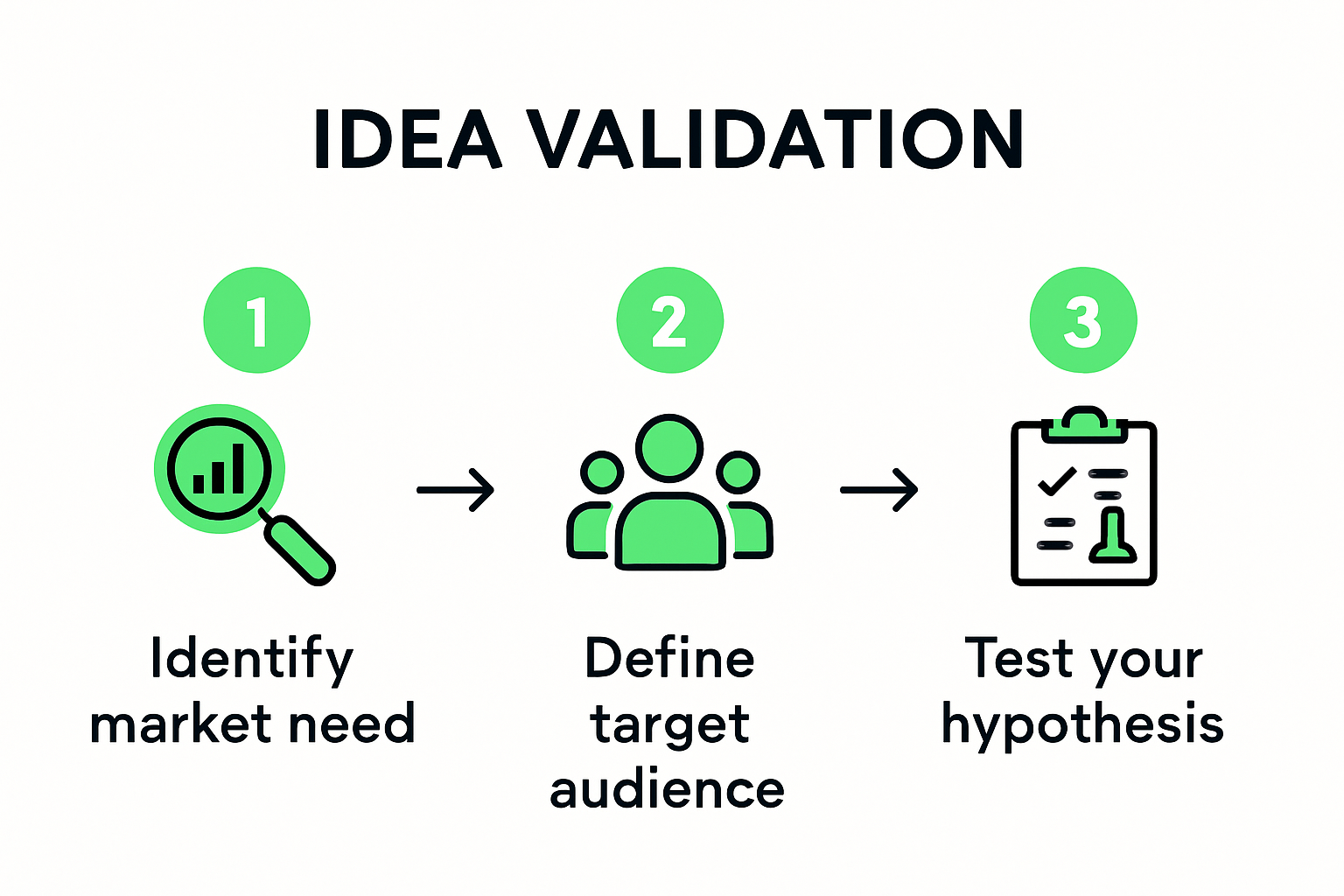
How to Validate Idea in 2025: A Simple Guide for New Founders
Building a startup feels thrilling when a new idea lights up your imagination and you want to run with it right away. Yet pause for a moment. About 90 percent of startups fail because their product never finds real demand. That sounds brutal and makes most people second guess themselves. Oddly enough, rigorous early testing is what gives new founders the confidence to charge ahead and often makes the difference between a total flop and a business that actually takes off.
Table of Contents
- Understanding Why Idea Validation Matters
- The Cost Of Skipping Validation
- Validation As A Strategic Approach
- The Validation Mindset
- Easy Methods To Test Your Business Idea
- The Minimum Viable Product Approach
- Customer Discovery And Feedback Techniques
- Prototype And Landing Page Testing
- Gathering Real Feedback From Potential Users
- Strategic Interview Techniques
- Designing Effective Feedback Mechanisms
- Interpreting And Acting On User Insights
- Turning Feedback Into Actionable Next Steps
- Organizing And Analyzing Feedback
- Developing An Action Plan
- Communicating Changes And Closing The Feedback Loop
Quick Summary
Understanding Why Idea Validation Matters
Founders often leap into entrepreneurship with excitement, passion, and a burning desire to transform their innovative ideas into successful businesses. However, the harsh reality is that most startups fail not because of poor execution, but because they build something nobody actually wants. Idea validation is the critical checkpoint that separates wishful thinking from strategic entrepreneurship.
The Cost of Skipping Validation
Most entrepreneurs invest significant time, energy, and often personal savings into developing a product or service without first confirming market demand. The U.S. Small Business Administration reveals that inadequate market research is a primary reason why approximately 90% of startups ultimately fail. This isn’t just a statistic - it’s a wake-up call for founders who believe their intuition alone can guarantee success.
Consider the typical scenario: An aspiring entrepreneur spends months developing a complex software solution, builds elaborate features, invests in branding, and creates a sophisticated website. But when they finally launch, crickets. No customers, no interest, just the sound of their investment evaporating. This painful scenario could have been entirely prevented through systematic idea validation.

Validation as a Strategic Approach
The National Academies Press report on Understanding the Entrepreneurial Mindset emphasizes that systematic evaluation of an idea’s feasibility is not just recommended - it’s essential. Validation isn’t about crushing dreams; it’s about refining them. It’s a structured process of testing assumptions, understanding customer needs, and iteratively improving your concept before significant resources are committed.
Effective idea validation involves multiple strategic steps: identifying your target audience, understanding their specific pain points, assessing market size, evaluating competitive landscape, and gathering real-world feedback. It’s like stress-testing your business concept before launching, ensuring you’re building something people genuinely need and are willing to pay for.
The Validation Mindset
Successful founders approach idea validation not as a one-time event, but as an ongoing conversation with potential customers. It requires curiosity, humility, and a willingness to pivot. Your initial idea is rarely your final product - validation helps you discover the true value proposition.
This approach transforms entrepreneurship from a high-risk gamble into a calculated strategy. By systematically validating your idea, you’re not eliminating risk entirely, but significantly reducing the chances of total failure. You’re creating a reality-tested roadmap that increases your startup’s probability of success.
Remember, every successful business started as an unproven idea. The difference between those that thrive and those that die is not just the idea itself, but the rigorous process of validation that transforms raw potential into a market-ready solution.
Easy Methods to Test Your Business Idea
Turning your brilliant idea into a viable business requires more than just enthusiasm - it demands strategic testing and validation. While the prospect of testing your concept might seem overwhelming, several practical and accessible methods can help you evaluate your idea’s potential without breaking the bank or consuming endless resources.
The Minimum Viable Product Approach
The Lean Startup methodology introduces a powerful concept for idea validation: the Minimum Viable Product (MVP). An MVP is the most basic version of your product that allows you to collect maximum validated learning about customers with minimal effort. Think of it as a prototype that answers critical questions about market demand and user interest.
For software entrepreneurs, this could mean creating a simple landing page that describes your solution, building a basic functional prototype, or developing a stripped-down version of your app with core features. The U.S. Chamber of Commerce recommends using MVPs to gather early feedback, test fundamental assumptions, and understand potential customer reactions before investing significant time and money.

Customer Discovery and Feedback Techniques
Effective idea validation relies on direct interaction with potential users. Start by identifying your target audience and designing systematic ways to engage them. This might involve:
- Conducting interviews: Speak directly with potential customers about their challenges and needs
- Creating online surveys: Use platforms like Google Forms or SurveyMonkey to gather structured feedback
- Hosting focus groups: Gather small groups to discuss your concept and gather nuanced insights
The HyMap technique offers a structured approach for software startups to systematically identify and test business hypotheses. By using cognitive mapping, entrepreneurs can create a more scientific framework for understanding customer needs and validating their ideas.
Prototype and Landing Page Testing
Before building a full-scale product, create lightweight representations of your solution. This could involve:
- Designing clickable prototypes using tools like Figma or InVision
- Building a simple landing page that describes your product’s value proposition
- Creating explainer videos that showcase your solution’s potential
- Using platforms like Product Hunt to get early feedback from tech-savvy users
The goal isn’t perfection but learning. Each interaction, whether positive or negative, provides valuable insights that help refine your concept. Successful entrepreneurs view these tests not as potential failures, but as opportunities to understand their market more deeply.
Remember, idea validation is an iterative process. Your first version will rarely be your final product. Embrace feedback, stay curious, and be willing to pivot. The most successful businesses are built not by stubbornly holding onto an original concept, but by continuously adapting based on real-world insights.
Gathering Real Feedback from Potential Users
Transforming a business idea into a successful venture requires more than intuition - it demands genuine insights directly from potential users. Gathering authentic feedback is an art form that goes beyond simple surveys or casual conversations. It’s about creating meaningful dialogue that uncovers hidden market needs and validates your core assumptions.
Strategic Interview Techniques
Harvard Business School Online emphasizes that customer validation interviews are crucial for understanding market dynamics. These aren’t just casual chats, but structured conversations designed to extract nuanced insights about user motivations, pain points, and potential solutions.
Key strategies for effective user interviews include:
- Ask open-ended questions: Encourage detailed responses instead of yes/no answers
- Listen more than you speak: Allow users to share their authentic experiences
- Avoid leading questions: Prevent inadvertently influencing their responses
- Record and analyze responses: Look for patterns and recurring themes
The Harvard Business School’s Rock Center Startup Guide recommends approaching these interviews with genuine curiosity. Your goal is to understand user behaviors, not to sell your idea prematurely.
Designing Effective Feedback Mechanisms
Research on design feedback reveals fascinating insights about gathering meaningful user input. A study on crowdsourced design feedback suggests that how you ask questions dramatically impacts the quality of responses. Presenting questions that provoke thoughtful reflection can yield more substantive insights than traditional survey methods.
Consider these advanced feedback strategies:
- Create scenarios that simulate real-world product usage
- Use prototype demonstrations to trigger authentic reactions
- Develop interactive feedback sessions where users can explore and critique
- Implement iterative feedback loops that allow continuous refinement
Interpreting and Acting on User Insights
Collecting feedback is only half the battle. The real skill lies in objectively interpreting user responses and strategically incorporating them into your product development. Look for consistent themes across multiple interviews, paying attention to:
- Specific language users employ when describing their challenges
- Emotional reactions to potential solutions
- Unexpected use cases or pain points you hadn’t considered
- Potential market segments you might have overlooked
Successful founders treat user feedback as a compass, not a mandate. Not every suggestion needs implementation, but every insight offers valuable perspective. Your job is to synthesize these diverse inputs into a coherent product strategy that genuinely addresses user needs.
Remember, great products aren’t created in isolation. They emerge from a deep, empathetic understanding of user experiences. By mastering the art of gathering and interpreting user feedback, you transform your idea from a personal vision into a market-driven solution that resonates with real people.
Turning Feedback Into Actionable Next Steps
Collecting user feedback is just the beginning of your validation journey. The real challenge lies in transforming those raw insights into strategic actions that can genuinely improve your business concept. This process requires a systematic approach that goes beyond simply listening and moves toward meaningful implementation.
Organizing and Analyzing Feedback
Forbes highlights the critical importance of establishing clear goals when processing user feedback. Not all feedback carries equal weight. Some insights will be transformative, while others might be tangential or even misleading.
Start by creating a structured framework for categorizing feedback:
- Frequency-based prioritization: Track how often specific issues or suggestions are mentioned
- Impact assessment: Evaluate which feedback could fundamentally improve your product
- Feasibility evaluation: Determine which suggestions are realistically implementable
The Impact Startup Academy recommends centralizing feedback data from multiple sources. This approach allows you to identify patterns, spot recurring themes, and develop a more comprehensive understanding of user needs.
To help you evaluate different feedback types and how to prioritize them, here is a table summarizing the main feedback evaluation criteria discussed:
Developing an Action Plan
Once you’ve analyzed the feedback, create a structured action plan. This isn’t about implementing every single suggestion, but about making strategic decisions that align with your core business vision.
Effective action planning involves:
- Mapping feedback directly to specific product features or improvements
- Setting clear timelines for potential changes
- Identifying potential risks or challenges in implementation
- Creating measurable objectives for each proposed change
Remember that pivoting doesn’t mean abandoning your original vision. It means refining and adapting your approach based on genuine market insights. The most successful startups view feedback as a collaborative process of continuous improvement.
Communicating Changes and Closing the Feedback Loop
Transparency is key when implementing user feedback. Communicate back to the users who provided insights, showing them how their input has directly influenced your product development. This not only builds trust but also encourages future engagement.
Consider these communication strategies:
- Send personalized follow-up emails explaining implemented changes
- Create public roadmaps showing how user feedback drives product evolution
- Host occasional user feedback sessions or webinars
- Provide clear documentation of how community input shapes your product
Turning feedback into actionable steps is an art form that requires patience, objectivity, and strategic thinking. It’s about finding the delicate balance between staying true to your original vision and being flexible enough to adapt to real-world user needs.
Ultimately, successful idea validation isn’t about achieving perfection on the first try. It’s about creating a responsive, iterative process that allows your business concept to evolve organically based on genuine market insights. Embrace feedback as a powerful tool for refinement, not as a criticism of your initial idea.
Frequently Asked Questions
What is idea validation and why is it important for startups?
Idea validation is the process of testing and confirming whether your business concept meets a real market need. It is crucial because it helps prevent wasted resources on products that don’t have demand, significantly reducing startup failure rates.
How can I test my business idea without a large investment?
You can test your business idea by creating a Minimum Viable Product (MVP), conducting surveys, hosting focus groups, or building simple prototypes and landing pages. These methods allow you to gather valuable feedback without significant upfront costs.
What are the best techniques for gathering user feedback?
Effective techniques for gathering user feedback include conducting structured interviews, creating online surveys with open-ended questions, and hosting focus groups to discuss your concept in-depth. Collecting insights from potential users helps refine your product and validates your assumptions.
How should I analyze and act on user feedback?
To analyze user feedback, categorize it by frequency and impact, and prioritize actionable insights. Develop an action plan that maps feedback to specific product changes, and ensure to communicate the updates back to your users, fostering trust and ongoing engagement.
Take the Uncertainty Out of Idea Validation With siift
You have seen how critical idea validation is for new founders. The article highlights how easy it is to waste time and money on products nobody wants. The problem is clear. Many people lack an unbiased way to test and refine their ideas before investing real resources. The pressure to get it right can feel overwhelming. siift gives you the power to validate your idea faster and with total confidence. Our AI guides you step-by-step through building Minimum Viable Products, customer discovery, and creating feedback loops. Use the same proven strategies from this guide, but let siift do the heavy lifting.
Ready to de-risk your journey and get personalized feedback you can trust? Turn your idea into a real business now. Do not wait for competitors or the market to decide your fate. Start for free today and let siift show you a smarter way forward.

see where you stand





.svg)
.svg.png)



.svg)

